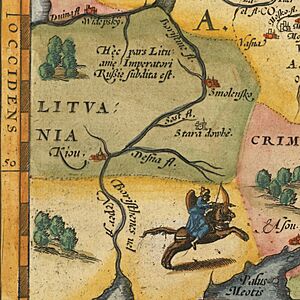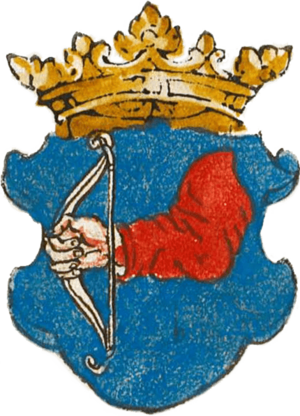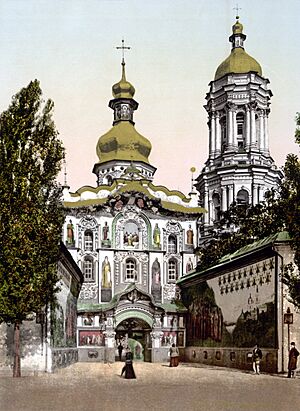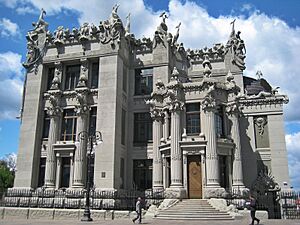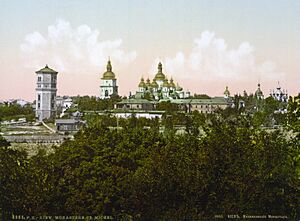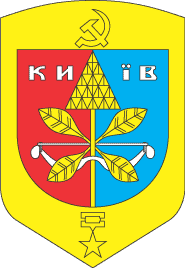History of Kyiv facts for kids
The history of Kyiv (also spelled Kiev) officially started when it was founded in 482 AD. However, people lived in the area much earlier, with archaeologists finding settlements from about 25,000 BC. Kyiv began as a Slavic settlement in the 6th century and slowly became a very important city for East Slavic people. Its "Golden Age" was from 879 to 1240, when it was the capital of a powerful medieval state called Kievan Rus'.
A famous legend says that three brothers, Kyi, Shchek and Khoryv, founded the city with their sister Lybid. They named it after Kyi, the oldest brother. Another legend says that Saint Andrew (who lived around 60-70 AD) was amazed by the beautiful hills along the Dnieper River. He supposedly predicted that a great city would rise there.
Kyiv's importance as a political center decreased in 1169 when Andrey Bogolyubsky's troops attacked and destroyed the old town. The capital then moved to Vladimir. After this, Kyiv was attacked and looted many times by different Rus' princes. It was completely destroyed in 1240 during the Mongol invasion.
For centuries afterward, Kyiv was a less important city on the edge of larger empires. These included the Grand Duchy of Lithuania, the Polish–Lithuanian Commonwealth, and later the Tsardom of Russia (which became the Russian Empire). However, Kyiv remained a key cultural center for the Ukrainian nation, especially during the Cossack Hetmanate in the 17th and 18th centuries. Kyiv became a Christian city in 988. It helped keep the traditions of Orthodox Christianity alive, even when under Catholic Poland or the atheist Soviet Union.
Kyiv grew a lot during Russia's industrial revolution in the late 1800s. After the October Revolution in 1917, it became the capital of several short-lived Ukrainian states. From 1921, it was part of the Soviet Union, and from 1934, it was the capital of Soviet Ukraine. During World War II, the city was almost completely destroyed again. But it recovered quickly after the war and became the third most important Soviet city. Today, it is the capital of Ukraine, which became independent in 1991 after the dissolution of the Soviet Union.
Contents
Early History of Kyiv
Legend says that East Slavs founded Kyiv in the 5th century. A family of founders included the Slavic leader Kyi and his younger brothers Schek and Khoryv, along with their sister Lybid. The name Kyiv (Ukrainian: Київ) means "belonging to Kyi" or "Kyi's place."
Slavic villages existed in the area from the late 5th century and later grew into the city. Some archaeological finds suggest trade activity in Kyiv's Podil district as early as the 7th or 8th century. However, other studies of old wooden homes show settlement evidence only from 887 AD. Some historians believe Kyiv as a town didn't truly exist before the late 9th or early 10th century.
Some Western historians think the city might have been founded by the Khazars or Magyars. One idea is that the name Kyiv comes from a Turkic language, meaning "riverbank settlement." However, the Primary Chronicle, an important old record, says that Slavic people in Kyiv told Askold and Dir that they had no local ruler and paid taxes to the Khazars. This happened in the 9th century. Some believe Kyiv was a Khazar outpost in the 8th and 9th centuries, with a fortress called Sambat (meaning "high place") built to protect the area.
No matter how it was founded, Kyiv's location was perfect for important ancient trade routes. By the 7th or 8th century, the Dnieper River became a main route between Scandinavia and the Byzantine Empire. Other rivers like the Desna also connected the area to the Don and Oka-Volga regions.
Kyivan Rus' and its Golden Age
According to the Primary Chronicle, Oleg of Novgorod took control of Kyiv in 882. He was a relative of Rurik, a Varangian (Viking) leader. From Oleg's takeover until 1169, Kyiv was the capital of Kievan Rus'. This state was ruled by the Varangian Rurikid family, who slowly became more like the Slavs. The Grand Princes of Kyiv were seen as the most important rulers.
In 968, the city was attacked by the nomadic Pechenegs but managed to defend itself. A very important event happened in 988: Grand Prince Volodymyr I (also known as St. Volodymyr) ordered all the people of Kyiv to be baptized in the Dnieper River. This marked the official Baptism of Kievan Rus into Orthodox Christianity.
Kyiv reached its peak, its "Golden Age," in the mid-11th century under Volodymyr's son, Yaroslav the Wise (who ruled from 1019 to 1054). In 1051, Yaroslav gathered bishops at St. Sophia Cathedral and appointed Hilarion as the first Metropolitan (head bishop) of Rus' who was born there. Even though Christianity later split into Eastern Orthodox and Roman Catholic, the church in Kyiv kept good relations with Rome for a while.
After Kievan Rus' started to break apart, the Principality of Kyiv formed. Different princes fought for control, and Kyiv's political power weakened. In 1169, Andrei of Suzdal sent an army against Kyiv. His allies won and looted the city for three days. They left the old town in ruins and took many religious artworks. Bogolyubsky then set up a new capital in Vladimir.
In 1203, Prince Rurik Rostislavich also captured and burned Kyiv. In the 1230s, the city was attacked and damaged several more times by different Rus' princes. Then, on December 6, 1240, Mongol-Tatar forces led by Batu Khan attacked and completely destroyed the city.
Under Mongol Rule
Between 1241 and 1362, the princes of Kyiv had to obey the Mongol/Tatar rulers. In 1245, Peter Akerovich, the Archbishop of Ruthenia, went to a meeting in France to tell Catholic Europe about the Mongol/Tatar threat. In 1299, Maximus, the head of the church in Kyiv, moved his main office from Kyiv to Vladimir-on-Kliazma, but he kept his old title.
In the early 1320s, a Lithuanian army led by Gediminas defeated a Slavic army and took over Kyiv. However, the Tatars also claimed Kyiv, so even though a Lithuanian prince ruled the city, it still had to pay taxes to the Golden Horde (the Mongol state).
Part of Lithuania and Poland
Kyiv became part of the Grand Duchy of Lithuania after the Battle at Blue Waters in 1362. In this battle, Algirdas, the Grand Duke of Lithuania, defeated a Golden Horde army. From 1362 to 1471, Lithuanian princes ruled the city. In 1471, the Principality of Kyiv was ended, and the Kyiv Voivodeship (a type of province) was created.
During Lithuanian rule, the main part of the city was in Podil. There was also a Lithuanian castle with 18 towers on Zamkova Hora (Castle Hill).
The city was often attacked by Crimean Tatars. In 1482, it was destroyed again by Crimean Khan Meñli I Giray. Even though Kyiv's political importance decreased, it remained a key center for the local Orthodox church. Starting in 1494, the city slowly gained more local self-rule, known as Magdeburg rights. This was completed in 1516 by King Sigismund I the Old.
Kyiv also had a notable Jewish community in the early 1500s. King Sigismund II Augustus gave Jews equal rights, meaning they paid the same taxes as other citizens.
In 1569, Kyiv and other Ukrainian lands became part of the Crown of the Kingdom of Poland under the Union of Lublin, which created the Polish–Lithuanian Commonwealth. Kyiv became the capital of the Kyiv Voivodeship. Its role as an Orthodox center grew stronger because Roman Catholicism was expanding under Polish rule. In 1632, Peter Mogila, the Orthodox Metropolitan of Kyiv, founded the Kyiv-Mohyla Academy. This school aimed to protect and develop Ukrainian culture and the Orthodox faith despite Polish Catholic influence. The academy offered education similar to Western European universities and became a leading learning center.
In 1648, Bohdan Khmelnytsky's Cossacks entered Kyiv during their uprising, establishing the rule of their Cossack Hetmanate in the city. The Cossack state was not fully independent for long, as the Polish–Lithuanian Commonwealth refused to recognize it. In 1654, Khmelnytsky signed the Treaty of Pereyaslav with the Tsardom of Russia to get military help against Poland.
Under Russian Rule
On January 31, 1667, the Truce of Andrusovo was signed. In this agreement, the Polish–Lithuanian Commonwealth gave Kyiv to the Tsardom of Russia for a period of two years. The Eternal Peace of 1686 made this permanent, placing Kyiv under Russian control for centuries. Kyiv slowly lost its self-rule, which was finally ended in 1775 by Empress Catherine the Great.
In 1834, St. Vladimir University was founded in the city. The famous Ukrainian poet Taras Shevchenko worked there. The local self-rule (Magdeburg Law) in Kyiv ended in 1834 by order of Tsar Nicholas I of Russia.
Even after Kyiv was no longer part of Poland, Poles continued to be important in the city. Many Polish nobles lived in Kyiv province. Until the mid-18th century, Kyiv had a strong Polish culture. Polish was the language of education in Kyiv during the 1830s. The Russian government ended Kyiv's self-rule partly because they feared Polish uprisings. Many Poles in Kyiv were friendly towards the Ukrainian national movement. Some poorer Polish nobles even became more Ukrainian in language and culture.
According to a Russian census in 1874, of Kyiv's 127,251 people, about 39% spoke Ukrainian, 11% spoke Yiddish, 10% spoke Russian, 6% spoke Polish, and 2% spoke German. Many people were listed as speaking "generally Russian speech," which often included Ukrainians and Poles who could speak enough Russian.
From the late 18th century to the late 19th century, Russian military and church matters increasingly shaped city life. Russian Orthodox Church buildings and businesses were a big part of the city. In 1845–1846, historian Mykola Kostomarov started a secret group called the Brotherhood of Saints Cyril and Methodius. Its members believed in a union of free Slavic peoples, with Ukrainians as a distinct group. The Tsar's government quickly stopped this group in 1847.
Kyiv experienced increasing "Russification" in the 19th century. This meant more Russians moved in, and Russian culture and language became more dominant. By the early 20th century, Russian was the main language in the city, though many working-class people still kept Ukrainian folk culture. Despite Russian cultural dominance, some ethnic Ukrainian nobles, military members, and merchants tried to preserve their native culture through secret book-printing and amateur theater.
During the Russian industrial revolution in the late 1800s, Kyiv became a major trade and transportation hub. It was important for exporting sugar and grain by railroad and on the Dnieper River. By 1900, the city had 250,000 people and was a significant industrial center. Important developments from this time include railway infrastructure, many new schools and cultural places, and famous buildings (mostly for businesses).
A large Jewish community also grew in Kyiv. This was partly because Jews were not allowed to settle in other parts of Russia like Moscow and Saint Petersburg. In 1836, the Pale of Settlement also banned Jews from Kyiv, limiting where they could live. In 1881 and 1905, terrible attacks against Jews, known as pogroms, happened in the city, leading to the deaths of about 100 Jews.
Kyiv also became known for aviation in the early 20th century. Famous aviation pioneers like Pyotr Nesterov (who invented aerobatics) and Igor Sikorsky were from Kyiv. Sikorsky built and tested the world's first helicopter in Kyiv. In 1892, Kyiv also got the first electric tram line in the Russian Empire.
Independence and Civil War
In 1917, a Ukrainian self-governing body called the Central Rada, led by historian Mykhailo Hrushevsky, was formed in Kyiv. Later that year, Ukraine declared its self-rule. This group competed for power with the Russian Army and later with the Bolsheviks.
On November 7, 1917, Ukraine declared itself an independent Ukrainian People's Republic with Kyiv as its capital. During this short period, the city's cultural and political importance grew quickly. A new Academy of Sciences and Ukrainian-language theaters and libraries were created.
However, the city soon became a battleground in a long and bloody struggle between Ukrainian, Polish, and Russian Bolshevik governments during the Russian Revolution, the Ukrainian-Soviet War, the Polish-Ukrainian War, and the Polish-Soviet War.
Ukrainian Soviet Socialist Republic
After the "January Uprising" was put down on January 29, 1918, Bolshevik Red Guards took the city in the Battle of Kyiv. This forced the Central Rada to flee. The Bolsheviks then made Kharkiv the capital of the Ukrainian Soviet Republic. By March, the Imperial German Army occupied Kyiv under the terms of the Treaty of Brest-Litovsk.
When German troops left after World War I, an independent Ukraine was declared in Kyiv under Symon Petliura. But Red Army forces recaptured the city in January 1919. In August 1919, the White armies took the city, but then lost it to the Bolsheviks again in December 1919.
The city was briefly occupied by the White armies before the Soviets took control again in 1920. In May 1920, during the Russo-Polish War, the Polish Army briefly captured Kyiv but were driven out by the Red Army.
After the Ukrainian SSR was formed in 1922, Kharkiv was made its capital. Kyiv, being an important industrial center, continued to grow. In 1925, the first public buses started running, and ten years later, the first trolleybuses were introduced. In 1927, some suburban areas were added to the city. In 1932, Kyiv became the main city of the new Kyiv Oblast.
Life in the 1930s
In the 1930s, the city suffered greatly from famine and from Stalinization. In 1932–33, Kyiv's population, like most of Ukraine, suffered from the Holodomor, a terrible famine. In Kyiv, bread and other foods were given out to workers using food cards, but even with cards, food was scarce, and people stood in lines overnight to get it.
In 1934, the capital of the Ukrainian SSR was moved from Kharkiv back to Kyiv.
Kyiv During World War II
During World War II, Nazi Germany occupied Kyiv on September 19, 1941 (see the Battle of Kyiv). This battle was a disaster for the Soviet side, but it slowed down the German advance. This delay allowed many important factories and businesses to be moved from Kyiv to safer parts of the Soviet Union. These factories then played a big role in making weapons for the Red Army to fight the Nazis.
Before the evacuation, the Red Army had secretly planted over ten thousand mines throughout the city, controlled by remote detonators. On September 24, after the German soldiers had settled in, the mines were set off. This caused many major buildings to collapse and set the city on fire for five days. More than a thousand Germans were killed.

Babi Yar, a place in Kyiv, became the site of one of the most terrible Nazi war crimes. In just two days in September 1941, at least 33,771 Jews from Kyiv and nearby areas were murdered at Babi Yar by the SS Einsatzgruppen (special Nazi killing squads). Babi Yar was also used for more mass murders of captured Soviet citizens in the following years, including Ukrainians, Romani, POWs (prisoners of war), and anyone suspected of helping the resistance movement. Perhaps as many as 60,000 more people were killed there.
The "Hunger Plan" was a Nazi plan made before their invasion of the Soviet Union. It aimed to make sure Germans got food first, at the expense of everyone else. The people of Kyiv were called "superfluous eaters" who were to be "gotten rid of" by cutting off all food supplies to the city. This food was meant to go to the German army and Germany's own population. Luckily for Kyiv's residents, this part of the plan was never fully carried out.
An underground resistance group quickly formed by local patriots. They were active until the Nazis were defeated. During the war, the city was heavily bombed, especially at the beginning. Kyiv was largely destroyed, including many of its famous buildings. Only one building remained standing on Khreschatyk, the main street.
The city was liberated by the Red Army on November 6, 1943. For its bravery during the war, Kyiv was later given the title Hero City.
Post-War Ukrainian SSR
After the war, Kyiv experienced fast growth and a period of peace. The Cold War arms race led to the creation of a strong technology industry in the city. This industry focused on aerospace, microelectronics, and precision optics. Many factories were built, employing highly skilled workers. Science and technology became very important in the city's intellectual life. Many research institutes in different fields formed the Academy of Sciences of the Ukrainian SSR.
Kyiv also became an important military center for the Soviet Union. More than a dozen military schools and academies were established there, also focusing on high-tech warfare. This created a need for workers, leading to many people moving to Kyiv from rural areas of Ukraine and Russia. Large suburbs and a wide transportation system were built for the growing population. However, many older, rural-style buildings and green areas survived on the city's hills, making Kyiv known as one of the world's greenest cities.
The city grew a lot from the 1950s through the 1980s. Important achievements during this time include the building of the Metro (subway system), new bridges over the Dnieper River (connecting the old city with suburbs on the Left Bank), and Boryspil Airport (which became the city's international airport).
The Chernobyl accident in 1986 greatly affected city life, both environmentally and politically. Some areas of the city were polluted by radioactive dust.
Independent Ukraine
After 57 years as the capital of the Ukrainian Soviet Socialist Republic within the Soviet Union, Kyiv became the capital of independent Ukraine in 1991.
See also
 In Spanish: Historia de Kiev para niños
In Spanish: Historia de Kiev para niños
- Timeline of Kyiv



